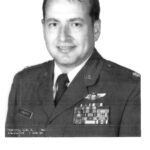2022 Honoree
U.S. Air Force
Vietnam
As a youngster in Salt Lake City, Loel B. Tibbitts wanted to go fast and to fly. With his older brother who was in the US Air Force as his role model, Tibbitts enrolled at the University of Utah in the ROTC program in the early 1960s. He wasn’t very studious; his real motivation was to fly. He learned about the Aviation Cadets, a WWII-era program for training pilots, where he could get his navigator rating and commission as a second lieutenant. He finished the yearlong program designed “to create a flight-rated officer” and went on for additional training as an electronic warfare officer. He spent two years navigating B-52s in Michigan before being accepted for pilot training at Webb AFB, California. He got his wings, spent two months training in the O2 aircraft; a noisy, single engine, high-wing prop plane, before arriving in Vietnam mid-summer 1968.
As a forward air controller, Tibbitts flew the unarmed O2 over the target areas, identified the target, marked it with smoke rockets, and when fighter jets arrived, directed them where to drop their bombs. “For as fast as the fighters were flying, it was hard for them to differentiate friendlies and hostiles in the dense, dark jungle with everyone in camouflage,” he said. “Simply put, our job was to identify the good guys and the bad ones.”
While flying cover for a reconnaissance team, Tibbitts repeatedly exposed himself to hostile fire while directing tactical aircraft against enemy positions. His aggressive handling of the situation saved his team. During a typhoon that blew into the Quang Ninh province, grounding all flying and shutting down the airbase, about 25 miles away, the 51st armored regiment was engaged in heavy fighting with the North Vietnamese. Tibbitts’ commander received a phone call begging for air support. Tibbitts volunteered for the mission.
With ceilings near 200 feet, Tibbitts and his commander were alone in a fixed-wing plane over hostile territory. They stayed in the area for 13 hours, making two successful runs into a nearby Marine airfield, reloading with fuel and rockets, returning to the area using their rockets defensively, trying to keep the pressure off while directing in needed supplies and medevac rescue.
Tibbitts went on to fly nearly 1,000 hours and 375 missions in the O2 before leaving Vietnam. He returned stateside to train B-52 pilots. Toward the end of the Vietnam War, during a second tour, he flew another 50 combat missions. Major Tibbitts spent the remainder of his 20 years of military service as an aircraft commander working with nuclear weapon systems.
“You’ve seen movies with the red phones?” Tibbitts asked. “I was the guy with the red phone.” Asked if that heightened his sense of vulnerability, he said, “No. It was just part of the job.”

